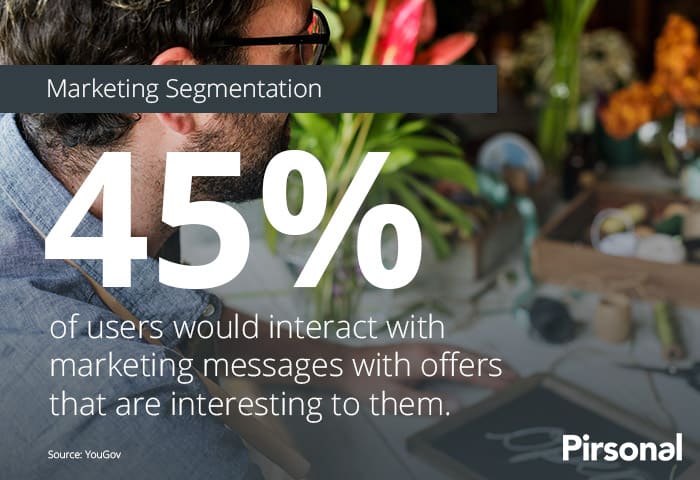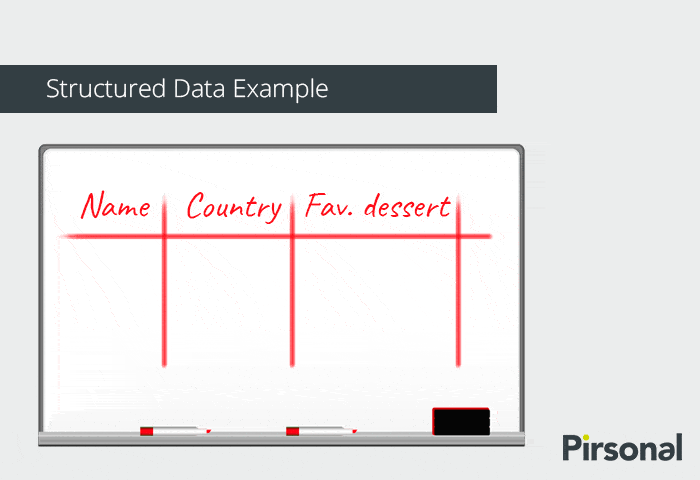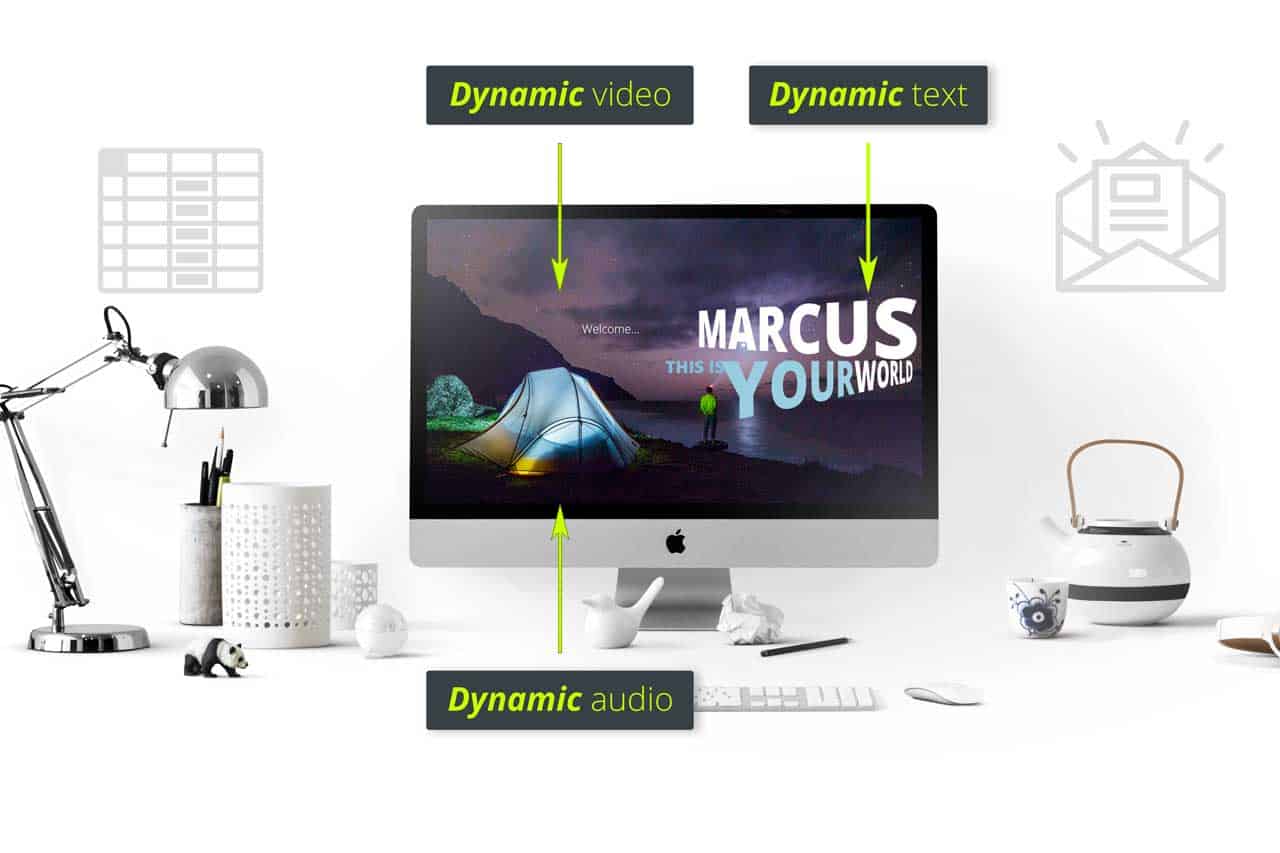Data-driven video design gives agencies and brands new opportunities to launch personalized videos campaigns that adapt to virtually unlimited creative scenarios.
From dynamic ads for advertising to personalized videos for email marketing campaigns, there are many creative use cases.
Here you’ll find some personalized video examples.
On the one hand, customers expect personalized experiences that are worth their time.
On the other, a well-crafted marketing strategy with personalization delivers a higher conversion rate.
But for many video production companies, advertising agencies, and marketers, creating personalized video campaigns is something new.
As the popularity of data-driven videos increases, creative teams need to understand some of the opportunities this brings to their game.
The ability to make videos in a scalable way is not just about using the right cloud video rendering software to mass create them.
In this article, you’ll learn why data-driven video marketing is important for creative teams.
What are data-driven videos?
Data-driven videos, also called personalized videos, are a type of marketing video organizations automatically make with dynamic content.
To create them, organizations need a video template and cloud video editing software that scales.
Video designers create personalized video templates using dynamic and static fields.
Dynamic or variable fields will be those available for mass personalization.
Depending on the cloud video editing software you use, this is the common dynamic content you can personalize in your videos:
- Images
- Text
- Video clips
- Audio files
- Vector content
- Scenes
- Properties and variables
With personalized video software like Pirsonal, you can personalize every single aspect of the video content, its properties, and variables.
However, other video personalization software may be less flexible and only support some content personalization.
3 reasons why data-driven video design is key to creative success
There are many reasons why data-driven videos are more popular than ever.
Let me cover three of these reasons:
#1 Agencies need new ways to be creative in advertising and automation
One of the reasons why data-driven videos are becoming so popular among agencies is because they help brands explore new ways to be creative in advertising and 1-to-1 marketing campaigns.
With this, creative teams are able to think about new ways to use variable data in the video scripts.
For example, the majority of brands love personalizing the first name of the viewer. From a creative perspective, there are many ways to print the name.
A video design trend is to use object tracking for text personalization.
But there are many other possibilities.
For instance, video production and advertising agencies can use an alpha channel or chroma key with dynamic content.
From a content perspective, I love the fact that as designers we can finally adapt the content to the buyer persona.
Brands can go as granular as they want or are able.

Often, creative studios are limited by the fact that most companies do not have enough structured information about their customers.
At the same time, many don’t really know how to use it in ways that catch their audience’s attention.
Because of this, most companies that create personalized video campaigns limit their game to basic customer data.
For example, data like first name, gender, and when they first bought a product or service.
Customer-oriented brands need to make an extra effort to retrieve, store and organize customer data.
Creative teams then work their magic to translate this structured information into something that triggers a reaction in the audience.
This will help them create relevant marketing content with a great chance of success.
There are also other ways to use video in creative ways. One of my favorites is interactive videos with personalization.
#2 There are more software integrations available
Another reason why dynamic video is growing is how popular digital data sources are nowadays.
From APIs to integrations or even spreadsheets, structured data is everywhere.

And more and more applications connect to more applications, regardless of the industry.
Among other things, the common data source for personalized video marketing depends on the goals, workflow, and who’s behind the project.
For example, data-driven videos use CRM software, spreadsheet, marketing automation tools, web forms, or simply any API.
In fact, many of our customers choose Pirsonal because of how easy it is to connect our video editing software to pretty much any third-party software.
In social media advertising or any other type of online advertising, brands can use first-party to third-party data depending on the level of personalization of the videos.
No matter the use-case, the reality is that most brands start data-driven video projects with spreadsheets.
Taking into account the data source will have an impact on the way video templates are designed.

For example, templates with a flexible structure will often require a custom integration with the video editing software for personalization.
APIs are the popular choice for these scenarios as the personalized video content type can completely change from one video to the other.
However, when the data source is a spreadsheet or an existing integration with marketing tools like Salesforce, Hubspot, or Microsoft Dynamics, templates with a fixed structure and content type are easier to manage and design.
#3 Customers want a personal touch in marketing communications
Another reason why data-driven video design is becoming popular is that with personalization, customer engagement goes up.
It is a known fact that customers expect a personal touch from brands.
In a world where customers are saturated, customer engagement is one of the top priorities for marketers.
The average shopper expects brands to remember them. This affects their preferences, their history, their location, their sentiments—on every channel, at any given time.
When organizations use one-to-one video, the click-through rate improves.
This is one of the critical reasons why brands are paying more attention to marketing segmentation.
We see an example in what Coast Digital did for one of their clients. With dynamic video ads, they achieved a 94% increase in CTR.
This along with the effort making a living video requires affects the way creative directors approach a project.
Most brands make data-driven video campaigns to improve customer experience.
In my experience, if it is a one-time video marketing campaign, chances are that they will not measure the CTR.
Nevertheless, companies that understand the need to measure customer engagement effectiveness will pay close attention to these conversions.
With this in mind, advertising agencies tend to create shorter videos to make people react.
By reaction I mean online shoppers that buy faster, sales lead that book a call or insurance customers that renew an insurance product and then become loyal customers.
Hows does this affect you as a creative designer?
Brands tend to want more information in the videos, which often translates into longer, irrelevant videos.
Regardless of the goal, my recommendation is to use the dynamic content as a way to help viewers react based on their particular context.
Final Words: Data-driven video design
Brands and agencies that follow a data-driven approach are more successful and creative in advertising.
Dynamic videos give creative teams an opportunity to stand out from the competition.
Customers demand marketing content that adapts to their needs.
Brands constantly see ways to increase customer engagement and return on ad spend (ROAS).
Data-driven video design gives creative teams a way to make responsive videos.
In a world where customers are saturated, dynamic videos help online shoppers not only pay attention to what brands have to promote but also react.
Creative teams need to go beyond what is cool and focus on what will trigger a reaction from the individuals within their audience.
This is what customers want and need.
Data-driven video design gives digital marketing teams a unique opportunity to delight customers and walk with them across the customer journey.

